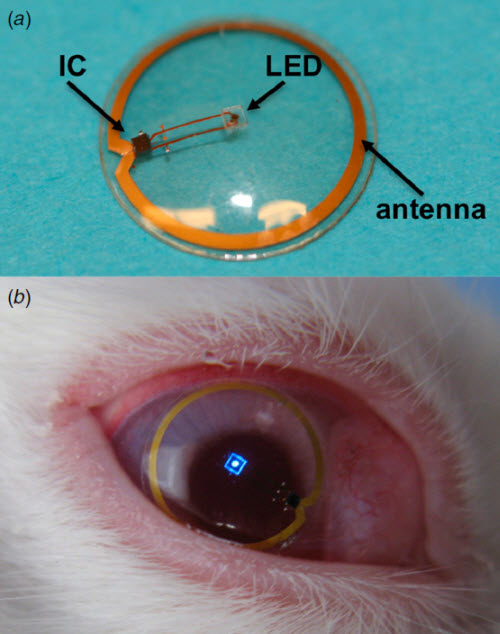歐美研究人員合作開發隱形眼鏡形式的顯示器
來自芬蘭阿爾托大學(Aalto University)與美國華盛頓大學(University of Washington)的研究人員合作開發了一種新式隱形眼鏡原型,可做為即時免持式顯示器使用;而且這種電腦化的隱形眼鏡據說已經透過動物眼睛的實際測試,證實安全無虞。

By David Ponce
Researchers from the University of Washington and Aalto University Finland have developed a prototype contact lens that contains a single LED pixel, a custom made integrated circuit and an antenna. They then tried the lens on live rabbits (under general anesthesia for comfort) with no adverse effects.
Awesome!
The display consists of an antenna, a 500 × 500 µm2 silicon power harvesting and radio integrated circuit, metal interconnects, insulation layers and a 750 × 750 µm2 transparent sapphire chip containing a custom-designed micro-light emitting diode with peak emission at 475 nm, all integrated onto a contact lens. The display can be powered wirelessly from ~1 m in free space and ~2 cm in vivo on a rabbit. The display was tested on live, anesthetized rabbits with no observed adverse effect. In order to extend display capabilities, design and fabrication of micro-Fresnel lenses on a contact lens are presented to move toward a multipixel display that can be worn in the form of a contact lens. Contact lenses with integrated micro-Fresnel lenses were also tested on live rabbits and showed no adverse effect.
So yeah, this is very rudimentary but… baby steps, baby steps! And while we don’t expect things to remain at the single-pixel level forever, later iterations will inevitably go up in pixel density very slowly. This means that when the first commercial generations reach the consumer level, it will likely only be for displaying things like text. But as the technology is further developed, we have no doubt that always-on alternate/augmented reality will become possible.
We’re several years away, but there you have it. Barring accidental death, if you’re under 60 today, there’s a good chance you will live to see this happen.
下一篇:鋰電技術突破-未來就在你身邊